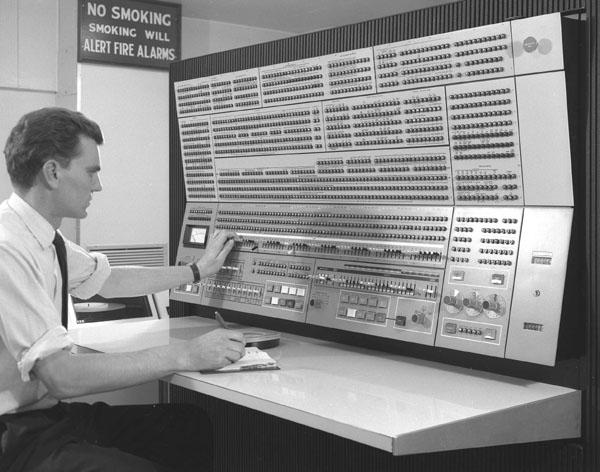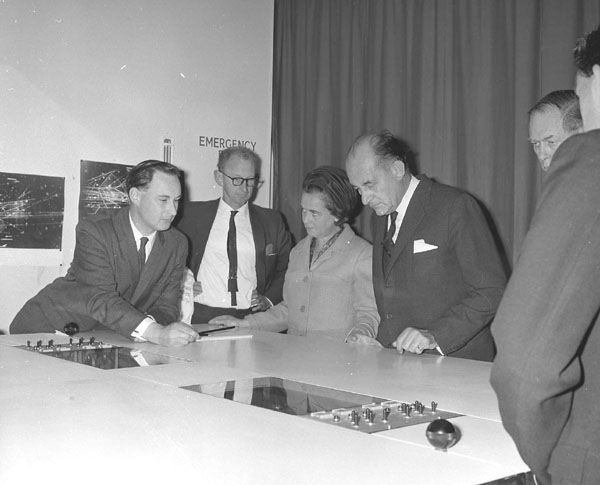

The work of this Division covers the fields of computing, film analysis, theoretical high energy physics, bubble chambers, super conducting magnets, cyclotron ion Sources and radiation protection. Details of the year's activities on each of these topics is given below.
The IBM 360 Model 75 computer was handed over to the Laboratory at the beginning of 1967. During the year an efficient computer service has been built up and is now running well on a two-shift basis. The work load has grown progressively and a third shift will be required by early March. The major change to the installation during the year has been the addition of the large capacity IBM 2314 disk store, which has relieved the pressure on space required by our growing libraries of users' programs. It has been necessary to retain the smaller IBM 2311 disks at present but these may be eventually replaced by a drum.

A special feature of the installation has been the growth of on-line usage. Two automatic film measuring devices - HPD and CRT flying spot machines - are now in operation and are attached to the Central Computer through a DDP 224. Several counter groups are now planning on-line connection of a variety of small computers and it is expected that four such users will be operational during the next six months.
During the year the number of jobs processed per week has risen from 1200 to 1900 and the availability of the machine from just above 80% to 92%. The content of the jobs has also changed; a year ago 40% of the time was spent in compiling, 20% in link editing, and 40% in execution. Corresponding figures today are 10%, 10%, 80%.
For the sake of the multiple on-line data acquisition system, the MFT1 operating supervisor - Multiprogramming Fixed number of Tasks - was used from the beginning. Possible successors to this, MFT version 2 and MVT - Multiprogramming Variable number of Tasks - are currently under study. Additions to the standard system were incorporated to exploit the Large Core Store, to facilitate transfer of control between the main on-line program and on-line users, and to re-order priorities so that long computing jobs such as Monte Carlo simulation studies can proceed concurrently with batch processing of short jobs.
MFT1 makes no attempt to overlap printing and card-reading with computing. To remedy this, HASP - Houston Automatic Spooling Program - was added to MFT1 and has been found very powerful and easy to use. It runs in the Large Core Store.
Since the most popular programming language in the Laboratory is Fortran, both the G and H compilers have been heavily used. Recently Cobol and PL/ 1 compilers have been made available but so far not greatly used. A number of standard procedures have been designed to simplify as far as possible the use of the computer by Fortran programmers. Three of the eight 2314 disks are reserved for libraries of user programs. For simple jobs the WATFOR system - a Fortran compile-and-go monitor designed by the University of Waterloo, Ontario - offers even simpler access and faster turn-round.
The Scientific Subroutine Package supplied by IBM has been extended by routines written at RHEL, and current work will bring in items from the Atlas and AERE Fortran libraries which perform functions not otherwise available.
The IBM 360/75 and the DDP-224 are connected via an 8-bit interrupt line and fast data channels through an IBM 2701 data adaptor and a hardware interface built at RHEL. Control programs have been developed which enable data, commands, and reports to be transferred between programs in the 360 and a maximum of 24 devices (including 8 typewriters) attached to the DDP-224. At present the HPD1 Flying Spot Digitiser and the Cathode Ray Tube film scanner are attached, with associated typewriters; the π4 experiment has been attached, for a time, via its PDP8 computer and will later be reattached. The data channel to the Nimrod Experimental Area is being rebuilt so that the K8, K12, and K14A experiments may be attached, all via local computers. The Calcomp Graph-Plotter and a large visual display are also available under Daedalus, but so far have not been heavily used although a comprehensive set of routines has been developed for the generation of straight line-elements, arcs of circles, and characters, and for automatic scale-transformations.
